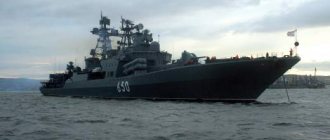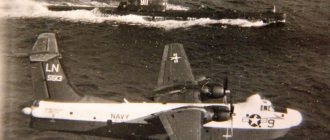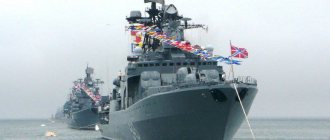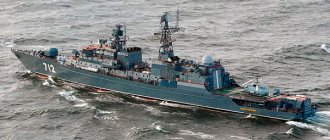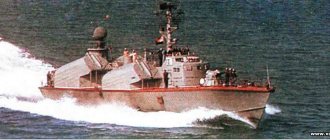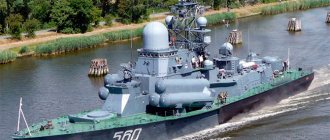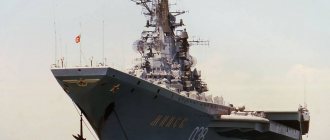Small anti-submarine ships Project 1331M
Quantity
12 units
Construction
GDR, Wolgast, Peneverft
Name
| Factory | Pawned | Launched | Commissioning | Note | |
| MPK-192 | №373 | 26.02.1985 | 29.08.1985 | 19.12.1986 | from 01/28/2011 - Urengoy |
| MPK-205 | №374 | 4.01.1985 | 28.12.1985 | 28.04.1986 | from 02/10/1998 - Kazanets |
| MPK-67 | №375 | 28.03.1985 | 19.04.1986 | 30.06.1987 | |
| MPK-99 | №376 | 25.06.1985 | 12.08.1986 | 28.12.1987 | from 10.28.2004 - Zelenodolsk |
| MPK-105 | №377 | 30.12.1985 | 20.11.1986 | 16.03.1988 | |
| MPK-213 | №378 | 8.04.1986 | 28.02.1987 | 29.07.1988 | |
| MPK-216 | №379 | 22.06.1986 | 25.06.1987 | 30.09.1988 | |
| MPK-219 | №380 | 7.11.1986 | 30.09.1987 | 23.12.1988 | |
| MPK-224 | №381 | 28.02.1987 | 30.03.1988 | 31.03.1989 | from 03/05/2005 - Aleksin |
| MPK-227 | №382 | 2.09.1987 | 16.08.1988 | 29.06.1989 | from 05.2015 – Kabardino-Balkaria |
| MPK-228 | №383 | 20.11.1987 | 31.10.1988 | 26.09.1989 | from 2.09.1999 - Bashkortostan |
| MPK-229 | №384 | 23.02.1988 | 30.01.1989 | 6.04.1990 | from 04/19/1996 - Kalmykia |
Tactical and technical data
| Displacement, t: | |
| standard: | 865 |
| complete: | 935 |
| Dimensions, m: | |
| length: | 75,2 |
| width: | 9,78 |
| draft: | 2.65 (overall - 4.4) |
| Full speed, knots: | 24,5 |
| Cruising range: | 2500 miles (12 kts) |
| Autonomy, days: | 10 |
| Power point: | 3x4750 hp, diesel engines M-504A-3, 3 fixed propellers, 1 diesel generator 500 kW, 2 diesel generators 200 kW each |
| Weapons: | 1x1 76 mm AK-176M - 300 rounds - SU MR-123 "Vympel" 1x6 30 mm AK-630M - 3000 rounds 2x2 533 mm TA (4 torpedoes) 2x12 RBU-6000 "Smerch-2" (96 RSL-60) - PUSB "Storm" 2x4 MTU-4U launchers SAM 9K32M "Strela-2M" (16 9M32M missiles) or 9K34 "Strela-3" (16 9M36 missiles) 2 bomb releasers (20 GB BB-1) |
| RTV: | General detection radar MR-352 "Positive", RTR radar "Bizan-4B", navigation radar MR-212/201-3 "Vaigach", GAK MGK-335MS "Platina-MS", OGAS MG-349M "Ros-K", Underwater sound communication sonar MG-35 “Shtil-2” Electronic warfare complex PK-16 (2 launchers KL-101) – rounds AZ-TST-60, AZ-TSP-60UM (since 1991), AZ-TSTM-60U (since 1994) |
| Crew, persons: | 80 (9 officers) |
General form
Small anti-submarine ship of project 1331M - General view
Modernization of the project
—
Distribution by fleet
BF
: MPK-67, 99, 105, 192, 205, 213, 216, 219, 224, 227, 228, 229
Side numbers
IPC-67: 03(1987), 233(1987), 242(1990), 301(1997) IPC-99: 04(1987), 255(1990), 308(1998) IPC-105: 05(1988), 245(1990) IPC-192: 01(1986), 262(1987), 247(1990), 304(2000) IPC-205: 02(1986), 277(1989), 223(1990), 311(1998) MPK-213: 06(1988), 222(1988), 226(1996) MPK-216: 07(1988), 258(2000) MPK-219: 08(1988), 209(1990) MPK-224: 09( 1989), 218(1990), 318(2016) IPC-227: 10(1989), 243(1990), 322(2017) IPC-228: 11(1989), 244(1990) IPC-229: 12(1989 ), 232(1990), 332(2016)
Write-off
2002 – MPK-219 (10.04) 2004 – MPK-213 (28.05) 2005 – MPK-67 (22.06), MPK-216 (22.06) 2010 – MPK-228 2014 – MPK-105
Export
GDR
: 16 units Volgast "Peneverft" - pr.1331 (German designation pr.133.1) small anti-submarine ships, from 1984 coastal defense ships Prenzlau, from 04.1981 Wismar 17, then 241 (serial number 346) 10/2/1978/07/6/1979/ 07/9/1981, Parchim 42, then 242 (plant no. 347) 10/2/1978/10/9/1979/04/9/1981, Perleberg 43, then 243 (plant no. 348) ?/?/09/19/1981, Bützow 244 (manager .№349) ?/12.03.1980/30.12.1981, Lyubz 221 (plant №350) 2.10.1979/11.06.1980/12.02.1982, Bad Doberan 222 (plant №351) ?/?/30.06.1982 , Güstrow 223 (plant no. 352) ?/12/31/1980/11/10/1982, Waren 224 (plant no. 353) ?/?/11/23/1982, Prenzlau 231 (plant no. 354) ?/06/26/1981/11.05 .1983, Ludwigslust 232 (factory No. 355) ?/10/1/1981/07/4/1983, Ribnitz-Damgarten 233 (factory No. 356) ?/12/28/1981/10/29/1983, Teterov 234 (factory No. 357) 1.07 .1981/27.03.1982/27.01.1984, Gadebusch 211 (plant no. 358) 08/17/1981/1982/31.08.1984, Grevesmühlen 212 (plant no. 359) 7.12.1981/3.09.1982/21.09.1984 , Bergen 213 (plant no. 360) ?/?/02/1/1985, Angermünde 214 (plant no. 361) ?/?/07/26/1985. Previously w/n 45. 75.2x9.8x2.85 (overall - 4.56) m, 1x2 57 mm AK-725, 1x2 30 mm AK-230, 4x1 400 mm TA, 24 kts, 2250 miles (12 kts) , 57 people, 7 days, general detection radar MR-302 “Rubka”
Indonesia
: 16 units In 07.1992: corvettes Captain Pattimura 371 (former GDR No. 231), Untung Suropati 372, then 872 (former GDR No. 233), Nuku 373, then 873 (former GDR No. 224), Lampung Mankurat 374 (former GDR No. 214 ), Chut Nya Dien 375 (formerly GDR no. 221), Sultan Thaha Syaifudin 376 (formerly GDR no. 222), Sutanto 377 (formerly GDR no. 241), Sutedi Senoputro 378 (formerly GDR no. 242), Wiranto 379 (formerly GDR no. 243 ), Memet Sastravirya 380 (former GDR No. 244) decommissioned in 2008 after a fire, Chiptadi 381 (former GDR No. 213), Hasan Basri 382 (former GDR No. 223), Iman Bonjol 383 (former GDR No. 234), Pati Unus 384 ( former GDR No. 232) decommissioned on 04/19/2017, Teuku Umar 385 (former GDR No. 212), Silus Papare 386 (former GDR No. 211). On No. 376 in 2015, 1x2 30 mm AK-230 was replaced by 1x7 30 mm
Germany
: 5 units Torpedo boats pr.140 Gadebusch R6167 (until 3.10.1990 GDR No. 211), Teterov R6168 (until 3.10.1990 GDR No. 234), Lyubts R6169 (until 3.10.1990 GDR No. 221), Wismar R6170 (until 3.10. 1990 GDR No. 241), patrol ship pr.630 Grevesmühlen R6164 (until 10/3/1990 GDR No. 212)
Small anti-submarine ships of Project 1331
Small anti-submarine ships of Project 1331M - 12 units.
MPK-192 (from 01/28/2011 — “Urengoy” ) 02/26/1985 / 08/29/1985 / 12/19/1986 MPK-205 (from 02/10/1998 — “Kazanets” ) 01/04/1985 / 12/28/1985 / 04/28/198 6 MPK- 67 03/28/1985 / 04/19/1986 / 06/30/1987 MPK-99 (from 10/28/2004 - “Zelenodolsk” ) 06/25/1985 / 08/12/1986 / 12/28/1987 MPK-105 12/30/1985 / 20. 11.1986 / 16.03.1988 MPK-213 04/08/1986 / 02/28/1987 / 07/29/1988 MPK-216 06/22/1986 / 06/25/1987 / 09/30/1988 MPK-219 / 12/23/1988 M PK-224 (from 03/05/2005 - “Aleksin” ) 02.28.1987 / 03.30.1988 / 03.31.1989 MPK-227 (from 05.25.2015 - “Kabardino-Balkaria” ) 09.02.1987 / 08.16.1988 / 06.29.1989 MPK-228 (from 02.0 9.1999 - “Bashkortostan” ) 11.20.1987 / 10.31.1988 / 09.26.1989 MPK-229 (from 04.19.1996 - “Kalmykia” ) 02.23.1988 / 01.30.1989 / 04.06.1990
Developed in the GDR on the basis of the Project 1124 MPK, they were built for their own Navy (Parchim type) and by order of the USSR. In terms of their technical characteristics, they are inferior to the prototype (there is no Osa-M air defense system), but they are distinguished by exceptionally high quality construction.
Displacement: full – 935 t standard – 885 t length – 75.2 m beam – 9.78 m draft – 2.8 m Diesel power – 3×4750 hp speed: full speed – 24.5 knots. economic - 12 knots. cruising range – 2200 miles Armament: 1 launcher of the Strela 2M air defense missile system (16 missiles), 1×1 76-mm AK-176M guns and 1×6 30-mm AK-630M guns, 2×2 533-mm TA and 2× 12 RBU-6000, 2 bsbr.
MPK-192 (serial number 373). 26.2.1985 was laid down at the slipway of the Peene-Werft shipyard in Wolgast (GDR) by order of the USSR, launched on 29.8.1985 and 7.3.1986 included in the lists of Navy ships, entered service on 12.19.1986 and included in the composition on 24.3.1987 DKBF. 26.7.1992 changed the USSR Naval flag to St. Andrew's.
MPK-205 , from 10.2.1998 – “Kazanets” (serial number 374). 4.1.1985 was laid down at the slipway of the Peene-Werft shipyard in Wolgast (GDR) by order of the USSR, launched on 12.28.1985 and 11.4.1986 included in the lists of Navy ships, entered service on 28.4.1987 and included in the composition on 2.10.1987 DKBF. 26.7.1992 changed the USSR Naval flag to St. Andrew's.
MPK-67 (serial number 375). 28.3.1985 was laid down at the slipway of the PeeneWerft shipyard in Wolgast (GDR) by order of the USSR and on 10.3.1987 was included in the lists of Navy ships, launched on 19.4.1986, entered service on 30.6.1987 and on 2.10.1987 included in the DKBF. 26.7.1992 changed the USSR Naval flag to St. Andrew's.
MPK-99 (serial number 376). 25.6.1985 was laid down at the slipway of the PeeneWerft shipyard in Wolgast (GDR) by order of the USSR and on 10.3.1987 was included in the lists of Navy ships, launched on 12.8.1986, entered service on 28.12.1987 and on 19.5.1988 included in the DKBF. 26.7.1992 changed the USSR Naval flag to St. Andrew's.
MPK-105 (serial number 377). 12/30/1985 was laid down at the slipway of the Peene-Werft shipyard in Wolgast (GDR) by order of the USSR and on 10/3/1987 was included in the list of Navy ships, launched on 11/20/1986, entered into service on 3/16/1988 and included in the composition on 5/19/1988 DKBF. 26.7.1992 changed the USSR Naval flag to St. Andrew's. In 1990, 1992 and 1993 won the prize of the Navy Civil Code for anti-submarine training (as part of the KPUG). MPK-213 (serial number 378). 8.4.1986 was laid down at the slipway of the Peene-Werft shipyard in Wolgast (GDR) by order of the USSR, launched on 28.2.1987 and 4.3.1988 included in the lists of Navy ships, entered service on 29.7.1988 and included in the composition on 9.11.1988 DKBF. 26.7.1992 changed the USSR Naval flag to St. Andrew's. In 1990 he won the prize of the Navy Civil Code for anti-submarine training (as part of the KPUG).
MPK-216 (serial number 379). 22.6.1986 was laid down at the slipway of the Peene-Werft shipyard in Wolgast (GDR) by order of the USSR, launched on 25.6.1987 and 4.3.1988 included in the lists of Navy ships, entered service on 30.9.1988 and included in the composition on 9.11.1988 DKBF. 26.7.1992 changed the USSR Naval flag to St. Andrew's.
MPK-219 (serial number 380). 7.11.1986 was laid down at the slipway of the Peene-Werft shipyard in Wolgast (GDR) by order of the USSR, launched on 30.9.1987 and 4.3.1988 included in the lists of Navy ships, entered service on 23.12.1988 and included in the composition on 1.3.1989 DKBF. 26.7.1992 changed the USSR Naval flag to St. Andrew's. In 1992 he won the prize of the Navy Civil Code for anti-submarine training (as part of the KPUG).
MPK-224 (serial number 381). 28.2.1987 was laid down at the slipway of the Peene-Werft shipyard in Wolgast (GDR) by order of the USSR and 4.3.1988 was included in the lists of Navy ships, launched on 30.3.1988, commissioned on 31.3.1989 and included in the DKBF on 21.4.1989 . 26.7.1992 changed the USSR Naval flag to St. Andrew's. In 1990 and 1993 won the prize of the Navy Civil Code for anti-submarine training (as part of the KPUG).
MPK-227 (serial number 382). 2.9.1987 was laid down at the slipway of the Peene-Werft shipyard in Wolgast (GDR) by order of the USSR, launched on 16.8.1988 and 20.2.1989 included in the lists of Navy ships, entered service on 29.6.1989 and included in the composition on 31.10.1989 DKBF. 26.7.1992 changed the USSR Naval flag to St. Andrew's.
MPK-228 , from September 2, 1999 – “Bashkortostan” (production number 383). 11/20/1987 laid down at the slipway of the Peene-Werft shipyard in Wolgast (GDR) by order of the USSR, launched 10/31/1988 and 20/2/1989 included in the list of Navy ships, entered service 9/26/1989 and 10/31/1989 included in the composition DKBF. 26.7.1992 changed the USSR Naval flag to St. Andrew's.
MPK-229 , from 19.4.1996 – “Kalmykia” (plant No. 384). 23.2.1988 laid down at the slipway of the Peene-Werft shipyard in Wolgast (GDR) by order of the USSR, launched on 30.1.1989 and 20.2.1989 included in the lists of Navy ships, entered service on 6.4.1990 and 29.12.1990 included in the composition DKBF. 26.7.1992 changed the USSR Naval flag to St. Andrew's. In 1992 and 1993 won the prize of the Navy Civil Code for anti-submarine training (as part of the KPUG).
Anti-submarine potential of the Russian Navy
One of the main tasks solved by the navy is the search and destruction of enemy submarines. Anti-submarine defense makes it possible to timely find and destroy submarines carrying ballistic missiles or reduce the threat of enemy multi-purpose submarines. To combat enemy submarine forces, the Russian Navy has various forces and means; Ships, submarines and aircraft are involved in the field of anti-submarine defense.
The principles of anti-aircraft defense provide for the use of various types of equipment and search, detection and destruction systems. The Russian Navy is armed with anti-submarine warfare aircraft and helicopters, as well as specialized anti-submarine ships. Similar tasks can also be solved by ships of other classes and submarines. At the same time, the Russian fleet does not have large stationary ASW lines similar to the well-known foreign SOSUS system.
Anti-submarine aircraft: the long arm of the fleet
Currently, the Russian Navy has a fairly large group of anti-submarine aircraft and helicopters of several classes. This technique allows you to monitor the situation both near bases or naval formations, and at a great distance from airfields. In theory, this ensures timely detection of enemy activity at a safe distance and before it reaches the line of use of weapons.
Tu-142M in flight. US Navy Photo
Naval aviation is armed with 22 aircraft of the Tu-142MK/MZ and Tu-142MR models; they serve as part of the aviation of the Pacific and Northern fleets. Now they are being modernized according to the Tu-142M3M and Tu-142MRM projects, respectively. Aircraft of the Tu-142 family are equipped with the Krypton radar, carry and use radio sonobuoys of various types, the Ladoga magnetometer, as well as data processing and storage facilities. The range of weapons includes depth charges, torpedoes and mines of several types. Depending on the modification, the combat radius of the Tu-142 reaches 5-5.2 thousand km.
There is the same number of Il-38 aircraft, some of which have been modernized according to the Il-38N project. The aircraft of the first modification carry the Berkut-38 search and targeting system. The modernized Il-38N are equipped with the Novella complex. In both cases, the PLO aircraft is capable of carrying an RSL, a magnetometer and a radar, as well as a computer for processing and storing data. Anti-submarine bombs, torpedoes and mines are used to combat underwater targets. The export modification of the Il-38SD can also use Kh-35 missiles. The technical range for the Il-38 of the first modification reaches 9,500 km, but the combat radius is limited to 2,200 km.
PLO Il-38N aircraft. Photo by UAC / uacrussia.ru
Several Be-12 aircraft remain in naval aviation. These vehicles are equipped with the PPS-12 search and targeting system with the Initiative-2B radar, the Siren-2M computing device, the APM-60 magnetometer and a number of other systems. It is possible to use several types of passive RGBs. They search for submarines for subsequent destruction using anti-submarine bombs or AT-1 or UMGT-1 torpedoes. The maximum flight range of the Be-12 reaches 4000 km, but the combat radius is smaller: when patrolling an area for 2-3 hours, this parameter is reduced to 600-700 km.
The Navy operates more than 60 Ka-27 anti-submarine helicopters. This vehicle carries the Octopus PPS, which includes the Initiative-2KM radar and the VGS-3 lowered hydroacoustic station. The helicopter carries RSL and equipment for working with them. The range of weapons includes small-sized torpedoes and missiles, as well as anti-submarine bombs. Ka-27 helicopters can operate both from coastal bases and from ships.
Ka-27 helicopter. Photo by the Russian Ministry of Defense / mil.ru
Surface ships vs submarines
The Russian Navy has a large number of ships and boats of all main classes, and it includes specialized ASW combat units. The fleet lists 9 large and 26 small anti-submarine ships of a number of projects. At the same time, ships of other classes – cruisers, destroyers, patrol ships, etc. – have certain capabilities in the context of anti-aircraft defense. Thus, any order of the Russian fleet is capable of searching for and destroying enemy submarines.
The BOD class in our Navy is represented by ships of projects 1155 and 1155.1. Project 1155 ships with a total displacement of 7,500 tons are equipped with the MG-335 Polynom sonar system with an antenna post mounted under the fairing on the bottom of the hull. The destruction of submarines is ensured by two torpedo tubes and RBU-6000 rocket launchers. There are two launchers of the URK-5 “Rastrub” anti-submarine missile system with eight missiles ready for use. The aft take-off platform supports the operation of two Ka-27 helicopters. Three Project 1155 BODs serve in the Northern Fleet, and the Pacific Fleet has four.
BOD "Admiral Chabanenko" pr. 1155.1. US Navy Photo
Project 1155.1 (total displacement 8900 tons) uses the Zvezda-2 SJSC with improved characteristics. Anti-submarine weapons include two RPK-6M Vodopad PLUR launchers for eight missiles, a pair of RBU-12000 bomb launchers and two torpedo tubes. The ability to carry two anti-submarine helicopters has been retained. The only BPR project 1155.1 “Admiral Chabanenko” belongs to the Northern Fleet.
The most popular in the Russian Navy are the Project 1124(M) MPKs. 20 such combat units are distributed among all major formations, with the exception of the Black Sea Flotilla. The original project 1124 provided for the construction of a ship with a total displacement of 1030 tons. It proposed the installation of the under-keel sonar "Argun" and the lowered "Shelon". During modernization, the ship became heavier up to 1120 tons. At the same time, the Argun was replaced by the MGK-335 Platina / Platina-M product. MPK pr. 1124(M) carries one or two RBU-6000 bow bomb launchers, as well as two twin-tube 533-mm torpedo tubes located on the deck.
The Baltic Fleet is the only operator of the Project 1331M MPK. He has seven such ships. The MPC with a displacement of 935 tons carries the MGK-335MS Platina-MS under-keel sonar and the MG-349 lowering station. Armament includes two RBU-6000 bomb launchers and two bomb releasers with an ammunition load of 10 depth charges. There are also two twin-tube torpedo tubes.
Armament of the BOD "Admiral Panteleev" pr. 1155. Photo by Wikimedia Commons
Anti-submarine equipment in our fleet is carried not only by specialized ships. For example, the aircraft-carrying cruiser Admiral of the Fleet of the Soviet Union Kuznetsov (Project 1143.5) is equipped with the Polynom-T sonar system and the Zvezda-M1 sonar system, and is also armed with two RBU-10000 bomb throwers and can carry anti-submarine helicopters. The heavy nuclear-powered missile cruiser "Peter the Great" (Project 1144) is equipped with the Polinom sonar system with two antennas in the hull and a towed antenna. It has 10 torpedo tubes, three bomb launchers of two types, and can also carry up to three anti-aircraft defense helicopters.
Ships of other classes and projects are equipped with one or another hydroacoustic means, as well as torpedoes or bomb launchers. At the same time, ships of small and medium displacement use such means not for anti-aircraft defense purposes, but for protection against enemy torpedoes. There are also interesting examples of a special approach to solving the problem. Thus, anti-sabotage boats Project 21980 “Grachonok” carry the lowered GAS “Anapa”, which is necessary to detect underwater activities of the enemy. Since the Grachata must fight combat swimmers, DP-64 and DP-65A anti-sabotage grenade launchers are used according to target designation from Anapa.
Submarines vs submarines
The Russian Navy has submarines of all main classes capable of solving a wide range of missions. In the submarine force, approaches to ASW are similar to those used by the surface fleet. Thus, there are a significant number of nuclear submarines and diesel-electric submarines, for which the search and destruction of enemy submarines is the main task. At the same time, strategic missile submarines can also perform similar tasks, but for them this is only a matter of self-defense.
MPK "Kholmsk" pr. 1124. Photo: Wikimedia Commons
SSBN pr. 667BDR with a displacement of 13 thousand tons are equipped with the MGK-400 Rubicon sonar, as well as the Aurora-1 and Shmel sonars. The bow compartment contains 4 torpedo tubes of 533 mm caliber and two 400 mm. The improved nuclear submarines Project 667BDRM have a displacement of 18.2 thousand tons and also carry other equipment. They carry the main MGK-520 Skat-BDRM SJC, and the weapon system includes only four 533-mm torpedo tubes. The newest SSBN Project 955 (displacement 24 thousand tons) have the MGK-600B Irtysh-Amphora-Borey sonar system, as well as a set of sonar systems for various purposes with the installation of antennas in various parts of the hull. To combat submarines, 6 torpedo tubes of 533 mm caliber are used, suitable for launching various types of ammunition.
SSGNs of Project 949A are equipped with a sonar system of the MGK-540 “Skat-3” type, which includes surveillance equipment and specialized sonar systems. There is also a towed GAS Pelamida. The weapon system includes two 650 mm torpedo tubes and four 533 mm. The Navy has eight Project 949A nuclear submarines, three of which are currently undergoing repairs. They are complemented by the new SSGN Project 885. These ships with a displacement of 13.8 thousand tons are equipped with the Irtysh-Amphora SJSC with an enlarged bow antenna. In the central part of the hull, 10 torpedo tubes are placed on the sides, compatible with torpedoes and mines of various types. So far, only one nuclear submarine, Project 885, is in service in the Russian Navy, but new boats will enter service in the near future.
SSBN "Karelia" pr. 667BDRM. Photo by the Russian Ministry of Defense / mil.ru
Several nuclear submarines carrying exclusively mine and torpedo weapons remain in service. These are two submarines of Project 945 and two Project 945A, three representatives of Project 671RTMK, as well as 11 nuclear submarines of Project 971. These ships are equipped with different types of sonar systems, mainly products of the Skat family. To use weapons, they have 533 mm and 650 mm torpedo tubes. In the past, some platoons could carry Granat cruise missiles launched from torpedo tubes. Some submarines are currently being modernized, as a result of which they receive the Kalibr-PL complex and the ability to use PLURs of this family.
The basis of the non-nuclear submarine force so far consists of 14 diesel-electric submarines Project 877, serving in all fleets, with the exception of the Caspian flotilla. Various modifications of Project 877 are equipped with the MGK-400 “Rubicon” sonar of several versions. The composition of such a sonar includes the main nose antenna and several additional sonars. There are six bow 533 mm torpedo tubes. The Black Sea Fleet has 6 newest diesel-electric submarines, Project 636.3. As a further development of Project 877, Project 636.3 provides for the use of the modernized MGK-400EM Rubicon-M GAK with improved characteristics. 6 torpedo tubes have been retained, but are now compatible with Caliber missiles.
Some conclusions
The Russian Navy has a large number of aircraft, surface ships and submarines capable of searching for and destroying enemy submarines. Such capabilities can be used to solve a wide range of problems – in theory, in all areas of the World Ocean. Naturally, the Russian Navy's PLO has strengths and weaknesses.
Multipurpose nuclear submarine "Tomsk" pr. 949A. Photo by the Russian Ministry of Defense / mil.ru
One of the main advantages of Russian anti-aircraft defense is the availability of a wide range of different means and samples capable of solving problems in different conditions. At the same time, the means to combat enemy submarines are available not only on specialized submarines and surface ships. This allows naval formations of different compositions to more effectively solve the problems of searching and detecting underwater objects.
The existing anti-submarine aircraft represented by Tu-142 aircraft can search for and hit targets or issue target designation at a great distance from the bases and borders of Russia. Il-38s with a smaller combat radius are designed to cover less remote areas. Ka-27 helicopters are capable of operating in the coastal zone; at the same time, they are the “long arm” of naval formations on the high seas, seriously increasing their situational awareness.
Nuclear submarine "Panther" pr. 971. Photo of the Russian Ministry of Defense / mil.ru
Surface ships - both specialized BOD/MPK and combat units of other classes - independently and with the use of carrier-based aircraft are capable of surveying all areas, from the coastal to the ocean zone. It also ensures the destruction of submarines by all available anti-submarine weapons or protection from approaching torpedoes. Submarines have similar potential, but they have a different armament and cannot support aviation.
The main disadvantage of the Russian anti-aircraft defense system should be considered the relatively small number of ships, submarines and aircraft. The lack of aircraft and ships does not allow us to organize constant duty in all potentially dangerous areas of the World Ocean. This makes it extremely difficult to deter the enemy by constantly escorting SSBNs along patrol routes and at SLBM launch lines.
A serious problem is the physical and moral obsolescence of both the equipment itself and its equipment. The share of completely new samples is not growing too quickly, but we cannot yet talk about a radical change. Specialized anti-submarine ships are not yet being built, although many modern projects provide for certain anti-submarine warfare systems. The construction of new hunting submarines is not carried out at the highest pace. New ASW equipment for naval aviation is not yet being built.
Diesel submarine "Novorossiysk" pr. 636.3. Photo by the Russian Ministry of Defense / mil.ru
The situation is positively influenced by the constant modernization of equipment using modern components. Thus, naval aviation is mastering improved versions of the Tu-142 and Il-38, and ships and submarines regularly undergo updates to their on-board equipment. Thus, without the massive construction of new models, the fleet is still increasing its anti-submarine potential. However, the rate of such growth may be insufficient.
Currently, the Russian Navy continues to recover from the catastrophic cuts of past decades. Along with other components, anti-submarine forces are being restored. However, the construction of a developed anti-aircraft defense system is not the only priority task, which leads to certain difficulties. At the same time, the field of anti-submarine defense has not been forgotten, and the maximum possible attention is paid to it. This allows us to look into the future with cautious optimism and expect that in the future the work of submariners of a potential enemy will become even more dangerous and difficult.
Based on materials from: https://mil.ru/ https://uacrussia.ru/ https://aoosk.ru/ https://flot.com/ https://flotprom.ru/ https://globalsecurity.org / https://deepstorm.ru/ https://airwar.ru/ https://ria.ru/ https://tass.ru/ IISS The Military Balance 2018
Description of design
Frame
The ship's hull is steel, smooth-deck, with a sheer bow and a widened bow superstructure that occupies the entire width of the hull. The ship was built using a longitudinal casting system and had upper and lower decks, a platform, a hold and a second bottom. The bow and stern superstructures, internal enclosures and part of the foundations were made of aluminum-magnesium alloys to reduce displacement. The mast is represented by a four-legged foremast and a tower-like mainmast of square section made of light alloys.
The ships were equipped with year-round cooling and air conditioning systems in residential, service areas and combat posts, which made it possible to maintain normal temperature, humidity, cleanliness and air changeability in the ship's premises. The ships are also equipped with a space heating and ventilation system, emergency cooling systems for the main engines and sea water supply, utility steam pipeline systems and a fresh water system. The ships were distinguished by exceptionally good quality of construction, good quality and reliability of equipment.
The ship's unsinkability was ensured by dividing the hull into 10 compartments by waterproof bulkheads. According to calculations, the ship should remain afloat when any two compartments are flooded, while the initial metacentric height and freeboard remain positive.
Power plant and driving performance
The main power plant is mechanical, three-shaft, with three M-504A diesel engines of 4,750 hp each. With. each, which worked through reverse gearboxes on three three-blade fixed-pitch propellers (FP). Engine M-504A with a rotation speed of 1,950 rpm. and power take-off flange rotation speed 522 rpm. had a service life of 3,500 hours before the first complete overhaul and a weight of no more than 7.5 tons. The main engines are controlled from the control panel using an automated remote control system. The ship's full cruising speed under three diesel engines was 24.5 knots.
The AC electrical power system of 380 V, 50 Hz was powered by three DG-300 diesel generators (YMZ V-12 diesel generators are installed on some ships of this project) with a power of 300 kW. Electricity distribution was carried out through 2 main distribution boards.
Service
All ships were enrolled in the Baltic Fleet (MPK-67; MPK-99; MPK-105; MPK-192; MPK-205; MPK-213; MPK-216; MPK-219; MPK-224; MPK-227; MPK- 228;MPK-229)
On February 7, 2007, a fire of the highest category of complexity occurred at the MPK Bashkortostan (228), which severely damaged the bow superstructure of the ship.
On September 23, 2022, the MPK Kazanets (205) collided with a civilian container ship in the Öresund Strait.
Side numbers:
MPK-67 - 03 (1987); 233 (1987); 242 (1990); 301 (1997)
MPK-99 - 04 (1987); 255 (1990); 308 (1998); "Zelenodolsk" (2004)
MPK-105 - 05 (1988); 245 (1990)
MPK-192 - 01 (1986); 262 (1987); 247 (1990); 304 (2000); "Urengoy" (2011)
MPK-205 - 02 (1986); 223 (1990); 311 (1998); "Kazanets" (1998)
MPK-213 - 06 (1988); 222 (1990); 226 (1996)
MPK-216 - 07 (1988); 258 (2000)
MPK-219 - 08 (1988); 209 (1990)
MPK-224 - 09 (1989); 218 (1990); "Alexin" (2005)
MPK-227 - 10 (1989); 243 (1990); "Kabardino-Balkaria" (2015)
MPK-228 - 11 (1989); 244 (1990); "Bashkortostan" (1999). Cut into metal in November 2015
MPK-229 - 12 (1989); 232 (1990); "Kalmykia" (1996)
